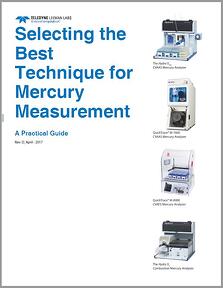 Selecting the right mercury analysis technique ultimately depends on your specific analytical needs. For many laboratories, particularly those involved in environmental analysis, the decision will be driven solely by the need to comply with a specific regulatory method.
Selecting the right mercury analysis technique ultimately depends on your specific analytical needs. For many laboratories, particularly those involved in environmental analysis, the decision will be driven solely by the need to comply with a specific regulatory method.
The regulatory methods include:
- Cold Vapor Atomic Absorption (CVAAS)
- Cold Vapor Atomic Fluoresence (CVAFS)
- Direct Analysis or Thermal Decomposition
If you’re lab is not required to follow a regulatory method, the driving force will likely be based on the characteristics of your sample matrix, the detection limits you need to reach for the matrix, your preference of digesting the sample or analysis in the native state, and your budget. Your answers to following five questions will help you decide which technique is the right for you.
- Are your samples liquid or solid? If your sample is a liquid than a chemical reduction technique may be the best because direct analysis requires additional time to dry the samples prior to decomposition. With a solid sample, you can choose to digest the sample and then analyze it with a chemical reduction technique or eliminate the sample digestion by using direct analysis. Labs that analyze both liquid and samples should consider a mercury analyzer that can be converted between direct analysis and CVAAS.
- What is the detection limit you need? Detection limit requirements will drive your decision between CBAAS and CVAFS if the sample is a liquid.
- Do you want to digest samples? The digestion process for most waters is straightforward and laboratories often have all the equipment they need to complete defined water digestions. Direct analysis by thermal decomposition may not be the right choice when the sample is solid because of troublesome matrix interferences.
- How much will direct analysis cost? The simplicity of direct analysis can be very appealing, but the costs may not justify the additional expenses, especially if the lab already has digestion procedures in place. Direct analysis may require an higher initial investment, but for those without digestion procedures, it does provide advantages that may lead to cost savings over the life of the system.
- What other matrix considerations are important? Factors such as sample heterogeneity or volatility should be considered. Samples that are not homogeneous or cannot be homogenized are best handled by digesting a larger quantity and then analyzing with CVAAS or CVAFS.
Teledyne Leeman Labs has put together a practical guide for selecting the best technique for mercury measurement. The guide includes a review of basic principles of mercury analysis, historical and current technologies, detailed descriptions of how the company’s mercury analyzers work and information about how to identify the right technique to fit your analytical requirements and costs structures.

